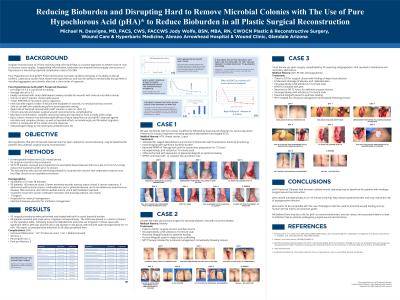Clinical Research
(CR-019) Reducing Bioburden and Disrupting Hard to Remove Microbial Colonies with the Use of Pure Hypochlorous Acid (pHA)* to Reduce Bioburden in All Plastic Surgical Reconstruction

The presence of bacterial colonies that are adherent to the tissue surface are recognized as deterrents to wound healing. The success of surgical reconstruction often relies on the ability to reduce the risk of postoperative infection. Evidence shows that pure Hypochlorous Acid (pHA) based cleanser*, is able to remove bacteria, associated slime like materials, and necrotic tissue that are all usually associated with problem wounds. Hypochlorous acid is also commonly known by its simple chemical formula, HOCl.
Methods:
We present a retrospective review of a series of 95 patients undergoing surgical reconstructive procedures over a 20 month period. All but 2 patients received pure Hypochlorous Acid (pHA) based cleanser that has a pH of 3.5 to 5.5, to help reduce the bacterial burden prior to closure. The two patients who did not were being treated for localized skin cancers that underwent resection and local flap closure as an outpatient procedure. The remaining 93 patients included 60 patients with pressure injury, 6 lower extremity wounds, 6 cancer resections, 6 abdominal wall reconstructions, 6 Hidradenitis and or pilonidal disease and 5 miscellaneous procedures (autoimmune disease, TMA neuroma, and 1 Morel-Lavallee lesion).
Results:
All patients receive pHA soak and or irrigation intraoperatively. The HOCl was placed in a sterile container on the operative table. Following excisional debridement and pulse vac irrigation in those cases with significant debris, pHA was poured onto a lap sponge, with the pHA soak intraoperatively for 10 min. We report no postoperative infections in all cases presented here.
Discussion:
Pure pHA or HOCl is a useful adjunct to address bioburden in reconstructive surgery. Wounds which are chronic and contaminated and or those with evidence of acute infection certainly benefit from this cleansing step. Additionally, the use of pHA/HOCL in general may be useful to any reconstructive procedure to reduce the risk of postoperative infection. Specifically, pHA/HOCL soak prior to closure, graft or flap may add an additional benefit with minimal additional operative time and or cost. Additionally, pHA/HOCl appears to be compatible with the biological matrices (CAMPS) used to promote surgical healing or as an adjunct to flap reconstruction.

.jpg)